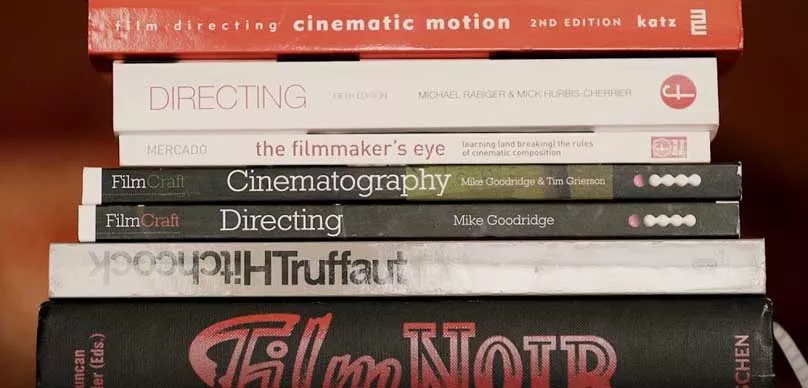1) Lighting for Cinematography
We can’t shoot good pictures without good lighting, no matter how good the newest cameras are. Shooting under available light gives exposure, but lacks depth, contrast, contour, atmosphere and often separation. The story could be the greatest in the world, but if the lighting is poor viewers will assume it’s amateurish and not take it seriously. Feature films and TV shows, commercials and industrial videos, reality TV and documentaries, even event and wedding videos tell stories. Good lighting can make them look real, while real lighting often makes them look fake. One of the best Cinematography Books out there.
2) The Five C’s of Cinematography: Motion Picture Filming Techniques
With the aid of photographs and diagrams, this text concisely presents concepts and techniques of motion picture camerawork and the allied areas of film-making with which they interact with and impact. Included are discussions on: cinematic time and space; compositional rules; and types of editing.
3) Cinematography: Third Edition
Since its initial publication in 1973, Cinematography has become the guidebook for filmmakers. Based on their combined fifty years in the film and television industry, authors Kris Malkiewicz and M. David Mullen lay clear and concise groundwork for basic film techniques, focusing squarely on the cameraman’s craft. Readers will then learn step-by-step how to master more advanced techniques in post production, digital editing, and overall film production.
4) Painting with Light
Few cinematographers have had as decisive an impact on the cinematic medium as John Alton. Best known for his highly stylized film noir classics T-Men, He Walked by Night, and The Big Combo, Alton earned a reputation during the 1940s and 1950s as one of Hollywood’s consummate craftsmen through his visual signature of crisp shadows and sculpted beams of light. No less renowned for his virtuoso color cinematography and deft appropriation of widescreen and Technicolor, he earned an Academy Award in 1951 for his work on the musical An American in Paris. First published in 1949, Painting With Light remains one of the few truly canonical statements on the art of motion picture photography, an unrivaled historical document on the workings of postwar American cinema.
5) Notes on the Cinematograph
The French film director Robert Bresson was one of the great artists of the twentieth century and among the most radical, original, and radiant stylists of any time. He worked with nonprofessional actors—models, as he called them—and deployed a starkly limited but hypnotic array of sounds and images to produce such classic works as A Man Escaped, Pickpocket, Diary of a Country Priest, and Lancelot of the Lake. From the beginning to the end of his career, Bresson dedicated himself to making movies in which nothing is superfluous and everything is always at stake.
6) Grammar of the Film Language
This unique magnum opus — 640 pages and 1,500 illustrations — of the visual narrative techniques that form the “language of filmmaking has found an avid audience among student filmmakers everywhere. This “language” is basic to the very positioning and moving of players and cameras, as well as the sequencing and pacing of images. It does not date as new technologies alter the means of capturing images on film and tape. Basic to the very scripting of a scene or planning of a shoot Arijon’s visual narrative formulas will enlighten anyone involved in the film industry — including producers, directors, writers and animators etc.
7) Cinematography: Theory and Practice: Image Making for Cinematographers and Directors
The world of cinematography has changed more in the last few years than it has since it has in 1929, when sound recording was introduced. New technology, new tools and new methods have revolutionized the art and craft of telling stories visually. While some aspects of visual language, lighting and color are eternal, shooting methods, workflow and cameras have changed radically. Even experienced film artists have a need to update and review new methods and equipment. These change affect not only the director of photography but also the director, the camera assistants, gaffers, and digital imaging technicians.
8) Film Directing: Shot by Shot – Visualizing from Concept to Screen
A complete catalogue of motion picture techniques for filmmakers. It concentrates on the ‘storytelling’ school of filmmaking, utilizing the work of the great stylists who established the versatile vocabulary of technique that has dominated the movies
since 1915. This graphic approach includes comparisons of style by interpreting a ‘model script’, created for the book, in storyboard form.
9) Lighting for Digital Video and Television, 3rd Edition
Enhance the visual quality of your motion pictures and digital videos with a solid understanding of lighting fundamentals. This complete course in digital video lighting begins with how the human eye and the camera process light and color, progresses through the basics of equipment and setups, and finishes with practical lessons on how to solve common problems. Filled with clear illustrations and real-world examples that demonstrate proper equipment use, safety issues, and staging techniques, Lighting for Digital Video presents readers with all they need to create their own visual masterpieces.
10) Film Lighting Talks With Hollywoods Cinematographers And Gaffers
Film lighting is a living, dynamic art influenced by new technologies and the changing styles of leading cinematographers. A combination of state-of-the-art technology and in-depth interviews with industry experts, Film Lighting provides an inside look at how cinematographers and film directors establish the visual concept of the film and use the lighting to create a certain atmosphere.
Kris Malkiewicz uses firsthand material from the experts he interviewed while researching this book. Among these are leading cinematographers Dean Cundey, Dion Beebe, Russell Carpenter, Caleb Deschanel, Robert Elswit, Mauro Fiore, Adam Holender, Janusz Kaminski, Matthew Libatique, Rodrigo Prieto, Harris Savides, Dante Spinotti, and Vilmos Zsigmond. This updated version of Film Lighting fills a growing need in the industry and will be a perennial, invaluable resource.

